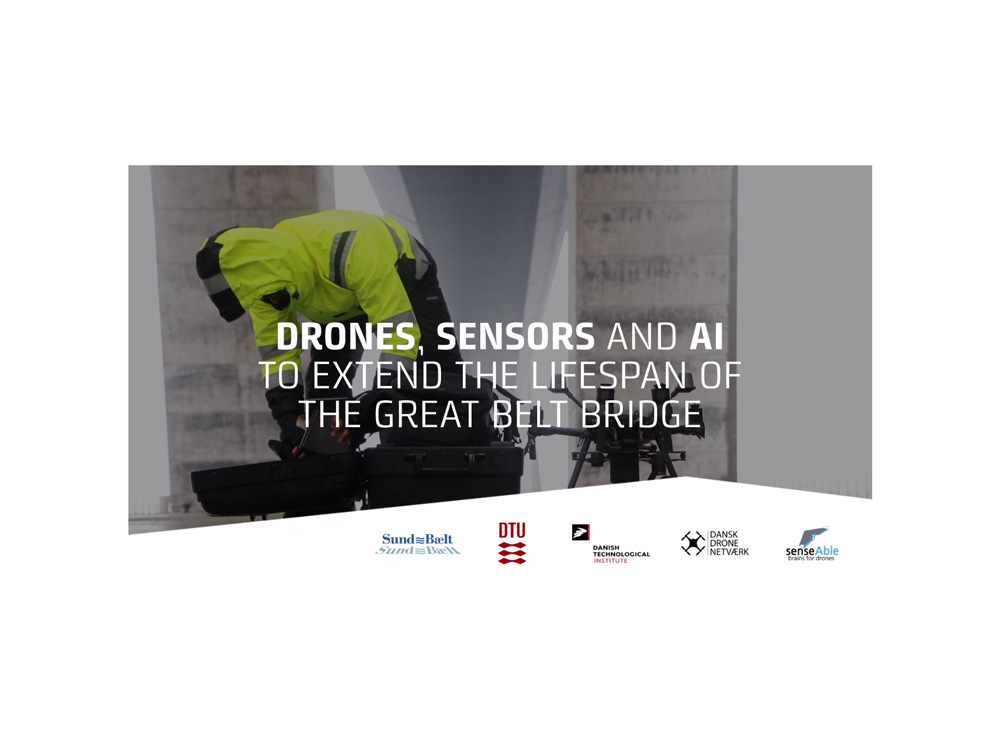Drones are the future of inspection: The Great Belt Bridge must outlive most of us

The Great Belt Bridge has been in use since 1998 and must last for at least 100 years. Therefore, the bridge is continuously maintained and inspected for cracks and wear.
So far, the bridge has been maintained by someone either rappelling down a rope or on a lift that carries them up and down the Great Belt Bridge’s enormous heights. But the rope and lift are beginning to be replaced with the inspection tool of the future, which is more climate-friendly and needs only a controller in hand.
Drones, sensors, and artificial intelligence are the new eyes and hands when it comes to making the Great Belt Bridge outlive most of us.
Until now, drones have only been used to find cracks in the bridge, but now it will also be possible to investigate how deep the cracks are, so that you find out more quickly whether the cracks need to be repaired or not.
This is exactly the topic of an Odense Robotics collaboration between Sund & Bælt, the Danish Technological Institute (DTI), the Technical University of Denmark (DTU), the Danish Drone Network and Senseable. The project is called DroneDeploy and it has examined the possibility of supplementing ropes and lifts with new technology.
“The drones are now being used for interventions and not just observation. Previously the drones took photographs and carried the pictures home, after which people still had to go out to check if the cracks were too deep and needed to be repaired. Now the drone can put pressure on the crack and see how deep it is and whether it is serious,” says Mathias Flindt, Consultant at DTI.
Greener maintenance
The drones – and the fact that they can now interact with the bridge – can prove to add time to the life of the Great Belt Bridge. Project Manager and Engineer at Sund & Bælt Finn Bormlund has no doubt about what the drones may mean for the future of the Great Belt Bridge.
“We reckon that the bridge will last about 100 years. But we would prefer 200 years – and the drones may help us achieve this,” Finn exclaims enthusiastically.
The extended lifespan saves not only time and money.
“The climate also benefits from extra birthdays. Producing and building with new materials such as steel and concrete have a noticeable effect on the CO2 footprint. Specifically, the bridge’s extra 100 years will save an extra 750,000 tonnes of CO2,” says Finn Bormlund.
From free-flying to landed
The drones are remote-controlled to fly around and check the condition of the bridge by photographing the surface of the concrete. That means the cracks in the concrete can be found faster and easier than by using a human climber.
But the really new thing is that we can now land the drone on the surface of the bridge, so that it is “stuck” in a good position to measure how deep the crack is.
“You know immediately whether it is a crack that needs to be repaired or whether it is just a cosmetic crack that does not require repair,” says Mathias Flindt.
Matteo Fumagalli, Associate Professor of Robot Technology and Unmanned Autonomous Aystems at DTU, is one of those developing the new type of drone for bridge inspection.
“The drone flies around the bridge structure looking for cracks using built-in sensors. Once a crack is detected, it first assesses whether a crack is critical using visual information from a built-in camera,” he says.
The drone will then land by critical-looking cracks on the surface – i.e., go from being free-flying to being “fixed”.
“The antenna manipulator then sits on the bridge and uses a robot arm to inspect the crack depth using ultrasonic sensors,” says Matteo and continues: “Drones can be used not only to make remote measurements with, for example, a camera, but also to use sensors and even tools that require a physical interaction with the environment. That’s the new thing about this project.”
Detects damage earlier
The entire Great Belt Bridge construction is checked from sea to sky every five to eight years during a general inspection, which requires lifts, cranes, and a large workforce.
“It requires a lot of resources to carry out inspections with a lift or rappelling when the whole bridge is to be checked. The lift must be able to reach a height of 254 metres, and we must block lanes and much more. Therefore, inspection takes place continuously over several years, and it is a very time-consuming process,” he says and concludes: “With the drones, we will be able to catch the damage earlier. By inspecting the cracks with a drone, it may be possible to inspect the bridge more often so that the cracks are caught before they become so severe that a major repair is needed.”
About the article and project DroneDeploy
The project was carried out under the auspices of RoboCluster, which has now become part of Odense Robotics. The project is supported by the Ministry of Higher Education and Science and the Region of Southern Denmark.
This article was provided by the Danish Technological Institute and was one of the projects presented at the hybrid event Robot Innovation Summit 2020.





